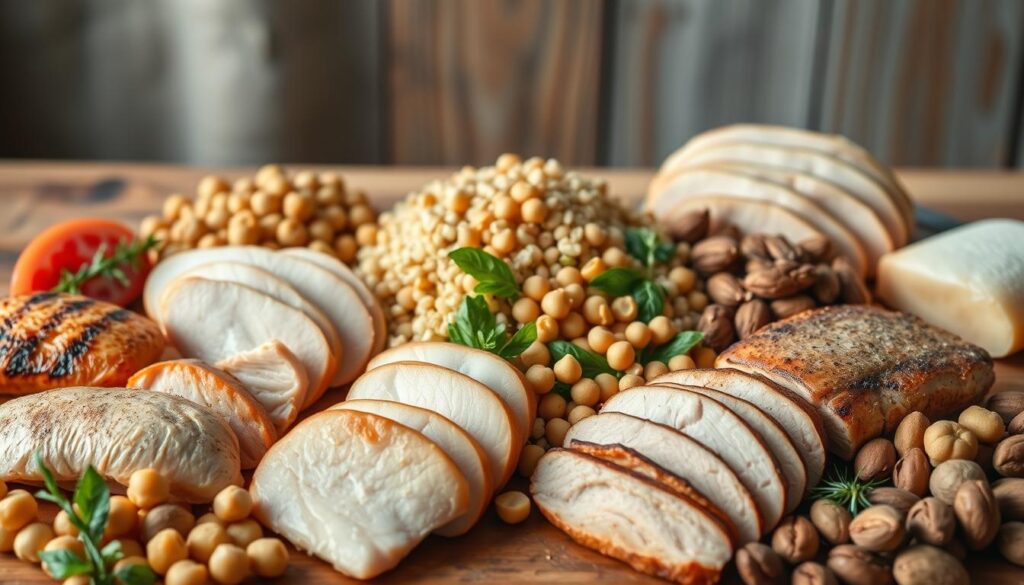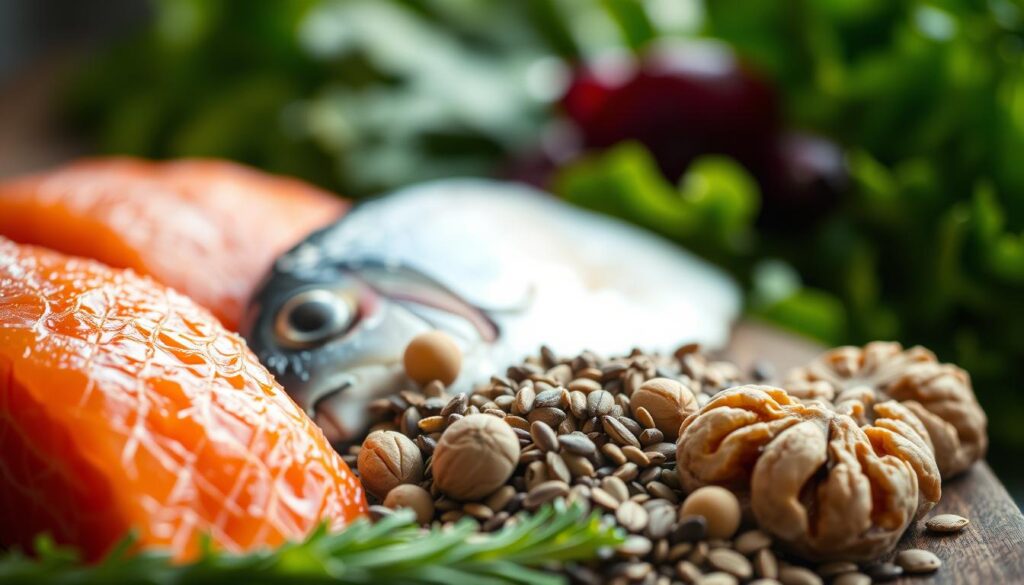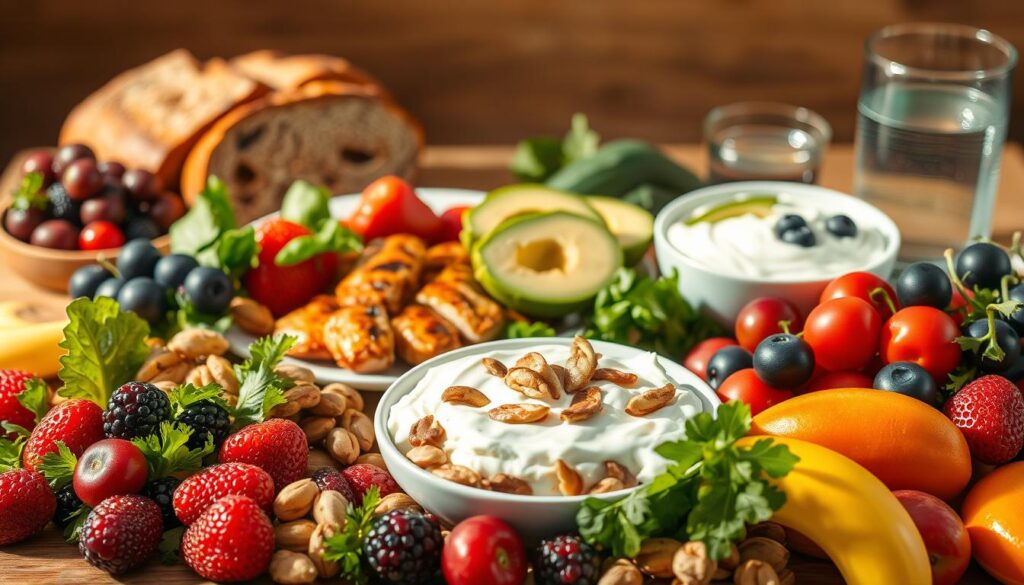Ever finish a tough workout only to feel like your energy tank is empty? That deep ache in your arms after lifting weights or the stiffness in your legs after a long run isn’t just fatigue—it’s your body asking for help. I remember staring at my fridge post-training, wondering why my efforts weren’t translating to results. Turns out, what you eat after exercise matters just as much as the workout itself.
Your muscles aren’t just built in the gym. They’re shaped in the kitchen, through smart choices that support repair and growth. Research shows pairing protein with the right carbs and fats can turn your meals into recovery powerhouses. Think of it like this: every bite either helps you bounce back faster or holds you back from progress.
Timing plays a bigger role than you might guess. Eating within that golden hour post-workout? It’s not a myth—it’s science. Your body absorbs nutrients best when it’s primed to rebuild, making that post-exercise meal your secret weapon for gains. But it’s not just about protein shakes; whole foods like eggs, sweet potatoes, and nuts deliver the full spectrum of vitamins and minerals your tissues crave.
Key Takeaways
- Nutrition works with exercise to speed up tissue repair and increase strength
- Carbs refuel energy stores while healthy fats reduce inflammation
- Eating within 60 minutes after training maximizes nutrient absorption
- Whole foods provide better long-term results than supplements alone
- Tailor your meals to your workout type for optimal recovery
- Balanced diets reduce soreness and improve workout performance
Introduction to Muscle Recovery and Growth
Behind every successful training session lies a complex cellular repair operation. When you exercise, tissues experience microscopic tears that act as biological alarms. These tiny injuries trigger your system to rebuild stronger fibers—nature’s way of preparing you for future challenges.
Your repair crew works overtime for up to 72 hours post-workout. During this window, three key processes occur: protein synthesis repairs damaged cells, anti-inflammatory responses reduce swelling, and energy stores refuel. This hidden labor determines whether your efforts translate to strength gains or stagnation.
Recovery isn’t limited to biceps or quads. Joints, tendons, and your cardiovascular network all demand attention. Neglect these systems, and you risk plateaus despite grueling gym sessions. Smart fueling strategies address the full spectrum of repair needs.
| Time Frame | Key Process | Nutrition Focus |
|---|---|---|
| 0-2 Hours | Protein synthesis activation | Fast-absorbing proteins |
| 24-48 Hours | Inflammation management | Omega-3 fatty acids |
| 72+ Hours | Tissue remodeling | Complex carbohydrates |
Timing matters, but consistency wins. While immediate post-workout meals grab attention, ongoing nourishment supports multi-day recovery cycles. Balance quick-acting nutrients with sustained energy sources to maintain repair momentum.
The Science Behind Muscle Recovery Foods
Imagine your muscles as construction sites needing specific materials to rebuild stronger. The right nutrients act like skilled workers, each with specialized tools to repair and reinforce tissues. This biological renovation project depends on three key crews: proteins, carbohydrates, and fats.
Understanding Amino Acids and Protein
Proteins break down into amino acids—the bricks your body uses to rebuild damaged fibers. Of the 20 types, nine are “essential” because you must get them from food. Leucine, found abundantly in eggs, acts like a foreman shouting “Start building!” to trigger muscle protein synthesis.
Complete proteins from animal sources contain all essential amino acids. Plant-based options often need pairing—like rice with beans—to provide full nutrient profiles. Research shows consuming 20-40g of protein within two hours post-workout maximizes repair efficiency.
Role of Carbohydrates and Fats
Carbs aren’t just energy boosters. They team up with proteins to shuttle amino acids into cells while refilling glycogen stores. Sweet potatoes and oats release energy slowly, maintaining blood sugar levels that support ongoing recovery.
Healthy fats from avocados or walnuts reduce inflammation and help produce testosterone—a key hormone for growth. Studies reveal balanced meals with all three macronutrients increase muscle protein retention by 22% compared to protein-only intake.
| Macronutrient | Primary Role | Top Food Sources |
|---|---|---|
| Protein | Fiber repair & growth | Eggs, Greek yogurt, salmon |
| Carbohydrates | Energy restoration | Quinoa, bananas, beetroot |
| Fats | Inflammation control | Chia seeds, olive oil, almonds |
Timing your nutrients matters, but consistency trumps perfection. A turkey sandwich on whole-grain bread with avocado delivers all three muscle-repair allies in one tasty package. Your tissues don’t need gourmet meals—just strategic combinations that keep the rebuilding process humming.
Best Foods to Eat for Muscle Recovery and Growth
Your kitchen becomes a repair shop after intense training sessions. Smart food choices deliver the raw materials your body needs to rebuild stronger fibers. Focus on lean proteins paired with complex carbs and anti-inflammatory fats for maximum impact.
Chicken breast and lentils shine as high-protein staples, offering 25-30g per serving with minimal saturated fat. But don’t stop there—pair them with quinoa or berries to create meals that refuel energy stores while reducing soreness.
| Protein Source | Grams per Serving | Bonus Nutrients |
|---|---|---|
| Salmon | 22g | Omega-3 fatty acids |
| Greek Yogurt | 17g | Calcium & probiotics |
| Edamame | 18g | Fiber & iron |
“Combining nutrients boosts absorption rates by 40% compared to isolated proteins,” notes a Journal of Sports Science study. This synergy explains why a turkey wrap with avocado beats a protein shake alone for sustained recovery.
Prioritize bioavailable sources your body uses efficiently. Eggs and cottage cheese provide complete amino acid profiles, while spinach adds magnesium to ease tension. Rotate your protein picks to cover all essential nutrients—variety prevents plateaus in both gains and taste buds.
Remember: quality trumps quantity. A handful of almonds post-workout delivers more repair-friendly fats than greasy fries. Your tissues reward strategic choices with faster healing and visible growth.
High-Quality Protein Sources
Choosing the right proteins determines how effectively your body repairs and strengthens tissues. Not all sources work equally—some deliver amino acids faster, while others provide extra nutrients that accelerate healing.

Eggs, Greek Yogurt, and Cottage Cheese Options
Eggs pack a complete amino acid profile, including leucine—the key trigger for muscle synthesis. Three large eggs deliver 18g of protein, making them ideal for post-workout meals or breakfast scrambles.
Greek yogurt stands out with double the protein of regular varieties. A single cup offers 17-20g, blending fast-absorbing whey and slow-digesting casein. This combo provides sustained fuel for recovery windows.
Cottage cheese shines with 28g per cup—the highest dairy source. Its curds release amino acids gradually, perfect for nighttime repair. Bonus: it’s rich in calcium for stronger bones supporting your gains.
Lean Meats and Seafood Benefits
Turkey breast delivers 26g of protein per 3-ounce serving—nearly fat-free. Its lean profile helps build mass without excess calories. Rotisserie chicken offers similar benefits for quick meal prep.
Salmon brings a double advantage: 17g of protein and anti-inflammatory omega-3s. These fats reduce soreness while supporting joint health—critical for consistent training.
- Combine fast (whey) and slow (casein) proteins for 24-hour recovery
- Prioritize leucine-rich foods like eggs and cottage cheese
- Use seafood twice weekly for omega-3 muscle support
Smart Carbohydrate Options for Energy
Your muscles need more than protein to bounce back—they demand strategic carbohydrate choices. While proteins repair tissues, carbs act as the primary fuel that keeps your engine running. Timing and quality determine whether these nutrients boost performance or leave you dragging.
Whole Grains and Starchy Vegetables
Quinoa delivers 40 grams of complex carbohydrates per cooked cup, plus 8g protein and 5g fiber. This combo refills glycogen stores while supporting muscle function with magnesium. Pair it with grilled chicken for a recovery powerhouse meal.
Sweet potatoes offer more than just energy. Their vibrant orange flesh packs vitamin A—critical for immune health during intense training cycles. One medium spud provides 27g carbs that release steadily, preventing energy crashes.
| Food | Carbs per Serving | Key Benefit |
|---|---|---|
| Brown Rice | 45g (1 cup) | Sustained energy release |
| Quinoa | 40g (1 cup) | Complete protein + fiber |
| Sweet Potato | 27g (medium) | Vitamin A for immunity |
Time your carb intake like a pro. Eating 30-60 minutes post-workout maximizes glycogen restoration. A banana with almond butter or oats with berries makes ideal quick fuel. These choices beat sugary snacks that spike and crash blood sugar.
Remember: not all carbs work equally. Whole grains and starchy veggies provide minerals like phosphorus for cellular energy production. They’re nature’s blueprint for keeping your tank full between sessions.
Essential Fats and Nutrients That Reduce Inflammation
Think of your muscles as engines needing premium fuel to run smoothly. While proteins grab headlines, healthy fats work behind the scenes to cool inflammation and speed repair. These nutrients act like skilled mechanics, fixing microscopic damage from workouts while preparing tissues for future stress.

Omega-3s: Your Cellular Repair Crew
Omega-3 fatty acids penetrate muscle cells like specialized tools. Studies show they help reduce exercise-induced swelling by 38% compared to other fats. A Journal of Physiology study found athletes consuming 2g daily gained 3% more lean mass in 12 weeks.
| Food Source | Omega-3 Content | Key Benefit |
|---|---|---|
| Salmon (3oz) | 1.8g | Reduces muscle soreness |
| Walnuts (1/4 cup) | 2.5g | Supports joint health |
| Flaxseed (2 tbsp) | 3.2g | Boosts recovery speed |
| Chia Seeds (1oz) | 5g | Enhances endurance |
These fatty acids team up with vitamins D and E to optimize hormone balance. They also help your body absorb crucial minerals like magnesium—vital for relaxing tense muscles post-workout.
Balance is key. Aim for omega-3 to omega-6 ratios between 1:1 and 1:4. Most Americans skew to 1:20, creating inflammation hot spots. Two weekly salmon servings or daily flax can restore healthy levels.
Don’t overlook synergy. Pairing walnuts with blueberries helps reduce oxidative stress better than either food alone. Your muscles thrive on these strategic combinations.
Delicious and Nutritious Snack Ideas for Recovery
Need quick fuel after sweating it out? Smart snacking turns recovery into a tasty pit stop. Portable options keep your nutrition on track without sacrificing flavor or results. Let’s explore bite-sized solutions that fit busy lifestyles.
Grab-and-Go Fuel Stations
Greek yogurt packs 17g protein per cup—perfect for rushed post-workout moments. Pair it with blueberries for antioxidants that fight exercise-induced stress. No spoon? Drinkable versions work while commuting.
Cottage cheese offers 28g protein per serving. Mix in pineapple chunks for natural sweetness and bromelain—an enzyme that eases muscle stiffness. Budget-friendly and ready in seconds.
| Snack | Protein | Key Benefit |
|---|---|---|
| Banana + Almond Butter | 6g | Replenishes electrolytes |
| Edamame (1 cup) | 18g | Plant-based complete protein |
| Hard-Boiled Eggs (2) | 12g | Fast-absorbing amino acids |
For plant-powered health, try roasted edamame. These crunchy beans deliver all nine essential amino acids. Keep a bag in your gym locker for emergency refueling.
Blender Magic Made Simple
Whip up a recovery smoothie with whey protein powder, spinach, and frozen mango. This combo delivers 25g protein plus vitamin C for collagen production. Use almond milk for dairy-free needs.
“Liquid food absorbs 40% faster than solids,” notes sports dietitian Dr. Ellen Pratt. Blend oats into your shake for sustained energy—ideal when your next meal is hours away.
Post-Workout Nutrition Timing and Strategies
Timing your meals isn’t just about convenience—it’s science. Your body enters a heightened state of nutrient absorption after exercise, making strategic fueling critical for reducing muscle soreness and maximizing gains. While flexibility exists, research shows eating within 30-60 minutes post-workout accelerates recovery by 23% compared to delayed meals.
Immediate Recovery Tips
Think of your post-training meal as a biological reset button. Combine fast-acting carbs like bananas with lean proteins—a 3:1 ratio works best to replenish energy and kickstart repair. Studies suggest post-workout nutrition strategies focusing on 20-40g protein within two hours yield optimal results for strength athletes and casual gym-goers alike.
Long-Term Dietary Considerations
Consistency beats perfection. Plan meals around your training schedule—eating every 3-4 hours maintains amino acid levels for ongoing tissue repair. Hydration matters too: water transports nutrients while flushing waste products causing stiffness. Over weeks, this approach helps your body adapt faster to sports demands.
Balance immediate needs with future goals. Nighttime cottage cheese snacks support overnight recovery, while omega-3-rich lunches combat inflammation from repeated workouts. Your diet isn’t just post-exercise—it’s the daily foundation enabling every rep, run, and result.
